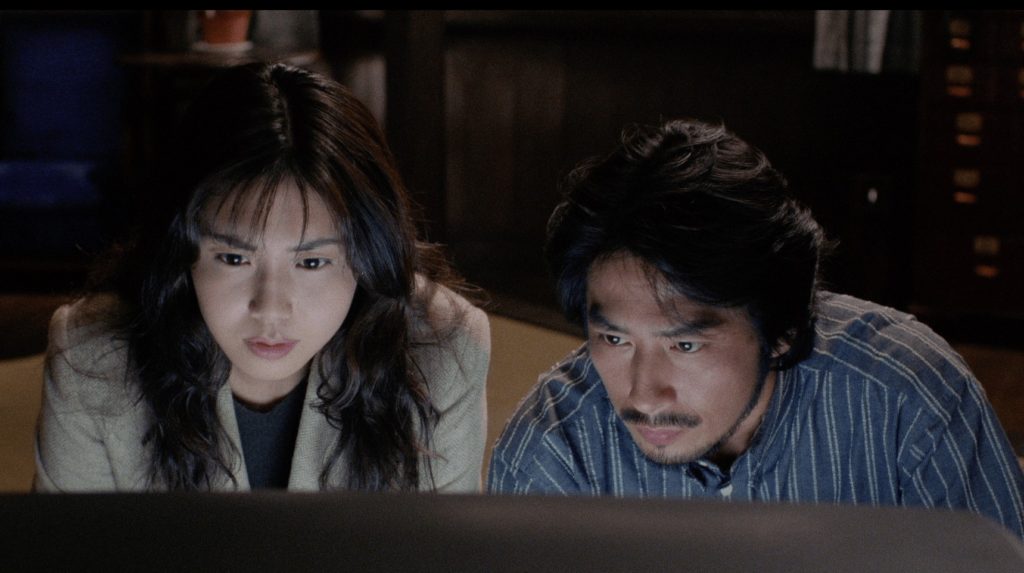Ringu
1998

Rating: NR
Genre: Horror
Country: Japan
Run-Time: 1h 36min
Director: Hideo Nakata
Cast
Nanako Matsushima…………Reiko Asakawa
Hiroyuki Sanada………………….Hayatsu
Rie Ino’o…………………………………..Sadaku
Released in 1998, Hideo Nakata’s Ringu is the amongst the oldest Master Works in The Midnight Selections. (It is only pre-dated by Kiyoshi Kurosawa’s Cure.) Filmed at a time when wall mounted telephones and VCR players were in every household, Ringu cannot conceal its age, especially since that old tech is central to its plot. But even so, a very solid case can still be made to declare Ringu the true starting point of a new era in modern horror. (If you have time, do a quick search on Google of the best horror films of 1998 and see the atrocious state horror was in before the turn of century.) While Hollywood was busy milking every last dollar out of old franchises and stale ideas, Ringu stood out as being a genuinely fresh take on the ghost story that took its cinematic inspiration from the past.
To think, it all (partially) started with a creepy long-haired girl.
Based on the popular novel by Koji Suzuki, Ringu tells the story of Reiko, a reporter investigating a strange urban legend about a cursed V/H/S tape that leaves people inexplicably dead in strangely contorted positions one week after viewing it. Reiko, like most people, starts off a bit skeptical about the tape’s existence, until she hear rumours that the tape may be connected to the death of her recently deceased teenage niece, Tomoko. After questioning Tomoko’s classmates, Reiko learns that Tomoko and three of her friends all died mysteriously on the same day, one week after renting a cabin in a nearby town. Curious, Reiko begins to investigate, finding the cabin and the cursed tape shortly after. The rest of the film involves Reiko’s race against the clock to use the images on the tape to help break the curse before she too falls victim to “Sadako’s rage.”
In the West, many people know this story from Gore Verbinsky’s admirable 2002 remake The Ring, which has its own fan-base. But for years prior to the American release, the Japanese version made its way into video stores and gained a strong cult following among horror fans and cinephiles. Countless hours have been wasted debating which film is better (it pretty much always comes down to which film you saw first), but, if you have seen neither, I strongly suggest seeing the original. While I admit that Verbinsky’s film has a few extra jump scares and the budget for better visual effects, Ringu earns its scares more honestly, confidently relying on its creepy atmosphere. More importantly, Ringu delivers one of the most frightening, iconic movie scares of the last few decades. This is the scare that matters the most, and it is a watershed moment in horror cinema. (Verbinsky’s recreation of this scene, which relies more heavily on CGI, is far less effective.) There is, after all, a good reason DreamWorks choose to remake this film, and why it ended up kick-starting a whole J-horror craze.
Though Ringu lacks polish, it reaps benefits from its practical effects and lower budget, giving it more of a timeless quality. The way it is filmed almost feels like a throwback to the best horror movies of the 70’s. The overt blood and gore found in most 90’s horror films of its time has been replaced here by an old-school desire to evoke the viewer’s imagination. The eerie surreal imagery in the V/H/S tape itself, which looks like a lost Bunuel/Dali collaboration, only adds to a viewer’s discomfort. And in contrast to the Verbinsky’s The Ring, which employs green-tinted lens filters to make every scene seem artificially cold (a common trend of American horror films in the early 2000s), Ringu is filmed clean, adding to the impression that this is happening in the real world. In many ways, this film is as prolific as Sadako’s mother. It pre-dates a new generation of filmmakers looking to return horror back to its more practical roots.
Now, I will admit, Ringu is not a perfect film. Even speaking Japanese, it is obvious that Nanako Matsushima is limited as an actress. The film is also slightly chauvinistic. Once Reiko’s ex-husband he introduced, he clearly gets to be the voice of reason and reflection. And Sadako’s bizarre origin story would also work if it was given to an X-Men villain. (Xavier should probably send out Wolverine to fight her.) But Ringu elevates itself above most supernatural serial killer stalkers films through its clever incorporation of the V/H/S tape, which at the time was a play on the silly pass-it-on-in-or-suffer-the-consequences chain-mail demands people regularly came across (because your idiot friend passed it on) during the early days of the Internet. Today, this subtext works better if viewed as a critique on the social need to create and spread urban legends. Reiko’s ex-husband even makes a profound remarks on the subject that still remain true. Also, Nakata, like so many other Japanese directors, seems to have an intuitive sense on how a ghost should look and, more importantly, move. Sadako is the stuff of nightmares- which is why, like Jason, Freddy or Micheal Myers, she is now considered a part of horror royalty. She has made her way across multiple countries (even Korea has added its own Ring installment) and into multiple films, remakes (though Americans changed her name to Samara) and onto television. In 2016, she even battled the vengeful spirits from the Ju-On franchise. In horror, you know you made it when you get a crossover.
Today, it is obvious the original Ringu had an undeniably profound influence on horror. Nearly every eerie aspect of this film has since been re-done to the point that it is now cliché, but there is an earnestness in the way Ringu was filmed that makes it still enjoyable to watch. It was the first of its kind, so is not trying to outdo anybody. And the mystery surrounding the images on the tape still is a compelling story. I doubt that Nakata knew he was about to bring about a new era in modern horror when he made his homage to past ghost stories, but in hindsight it is clear he did just that.
